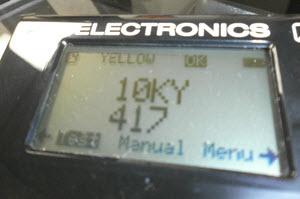How to Test Gold with Electronic Tester
Electronic Gold Testing
How Properly Test Gold Items with Electronic Gold Testers and Properly Interpret the Results
One of the most common, and most effective methods of testing if an item is gold, or not, is by using electronic gold testing. However, as you will see soon, this method is not infallible. As a very active gold buyer, I use electronic gold testers every day. To me electronic gold testers are a critical tool. The video below clearly shows an electronic gold tester at work.
Topics Covered:
- What is electronic testing
- How does electronic testing work
- Advantages of electronic gold testing
- Equipment
- What does electronic gold testing indicate
- What does electronic gold testing not indicate
- How to properly electronically test gold
- How to interpret electronic gold test results
- Tricky materials
- Conclusion
- Video
- Disclaimer
Electronic gold testing is just one indicator that an item may or may not be gold, and what its level of fineness may be. What is important is to know how to interpret the electronic test results. It is very easy to misinterpret electronic gold testing and end up buying something that is not gold, that the gold alloy item is of lower fineness than expected. This article is about how to properly perform and interpret electronic gold tests.
Electronic gold testers are getting better and better, but their operational process remains the same. In this article you will learn enough to be effective at using electronic gold testers.
What is Electronic Testing
Electronic gold testing is the testing of gold item based on their electrical conductivity. This type gold testing provides this critical information:
- It closely approximates the fineness of the gold item (10K, 14K, etc)
- Indicates whether or not the item is a karat gold alloy or not (6K and above)
- Indicates if the item is not gold
How Does Electronic Testing Work
Electronic gold testing works by, through a conducting medium, applying an electrical charge to an item, and with a sophisticated sensor, measuring its level of resistance. The sensor’s output enters a computerized system, that algorithmically correlates the resistance level to known gold alloy conductivity signature. The result is digitally displayed for the user to read.
Example:
A piece of jewelry is tested. After the electrical charge is applied, the output of the sensor goes into the computerized system. If the material’s conductivity signaturel is comparable to known 14K gold alloy, the algorithm will correlate that output to the result “14K”. That result will be shown digitally in the electronic gold tester display.
Gold based alloys are a mix of gold, silver and copper. White gold is the same, with the addition of usually nickel. Some white gold contains palladium instead of copper and nickel. Electronic gold testers have manual adjustments to account for that.
Advantages of Electronic Gold Testing
- Highly reliable (but not infallible)
- Non-destructive
- Highly approximates gold alloy fineness
- Not hazardous (nitric acid is hazardous)
- Tests the mass rather than just the surface, so it provide a very good fineness approximation
What Does Electronic Gold Testing Indicate
- Whether the conductivity signature of the alloy being tested corresponds to gold or not
- To which type of known gold alloy fineness does the conductivity signature most closely resembles
What Does Electronic Gold Testing NOT Indicate
- Whether the alloy tested qualifies as karat gold or not
- Guarantee the exact fineness of a gold based alloy
How to Properly Electronically Test Gold
Properly performing electronic gold tests is critical. The result highly depends on this. Here is the process.
- If the piece is not totally clean, clean it. This is specially important with chains and other items that can collect dirt
- If needed clean the surfaces to be contacted with an eraser
- Place the gold item in the contact surface or alligator clip
- Place the probe on the gold item
- Make sure conductor fluid reaches the gold item
- Apply the charge and wait for the results
- If the results are negative the tester will indicate “not gold”. Test again in a few extra locations.
- If the results are positive, the display will indicate the fineness of the item (14K, 18K, etc)
- Test again in a few extra places to make sure that the results are steady. Use the value that most often comes as a result your fineness determination
For more information Tri Electronics Inc
How to Interpret Electronic Gold Testing
As explained above, that an electronic gold test indicates a certain level of gold fineness DOES NOT exactly means that the item is gold. It means that its electronic conductivity signature closely resembles what the algorithm in the tester recognizes as a type of gold alloy.
- Maybe after the seller decides to sell based on the offer, with a file, remove some of the gold item’s surface and test again to see if the result are the same
- If the grading matches the karat stamp, then most likely the gold item’s fineness is a per the stamp
- If not, maybe the item is gold plated over base metal, or higher karat gold plated over lower karat gold
This is when experience comes into play. If all points out towards the item tested being gold, most likely it is. If not, most likely it is not. If in doubt, use nitric acid testing and magnetic testing.
Tricky Materials
Certain materials electronic conductivity closely resemble that of karat gold alloys. Below are the main items to look for. There are more. People have been trying to simulate gold since almost the beginning of mankind
- Surgical grade stainless steel – Can show as 14K or 18K gold
- Zinc gold alloy – Not karat gold because of super low content – Can show like 10K
- Heavy gold filled and plated. Can show as good as 14K
Conclusion
Electronic gold testing is extremely effective at determining whether an item is a karat gold alloy or not, and its possible fineness. This system is not infallible, but a highly reliable indicator. It is important to test properly, correlate results to other facts, and do additional testing if necessary. Electronic gold testing is extremely useful for gold buying.



![[Most Recent Quotes from www.kitco.com]](http://www.kitconet.com/charts/metals/gold/t24_au_en_usoz_2.gif)
![[Most Recent Quotes from www.kitco.com]](http://www.kitconet.com/charts/metals/silver/t24_ag_en_usoz_2.gif)
![[Most Recent Quotes from www.kitco.com]](http://www.kitconet.com/charts/metals/platinum/t24_pt_en_usoz_2.gif)










